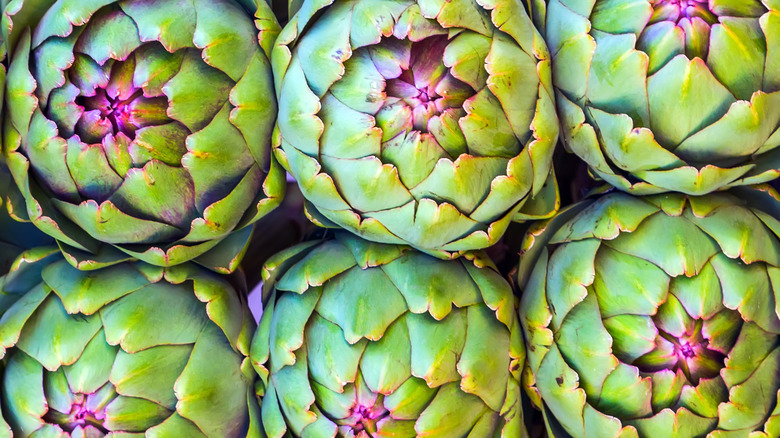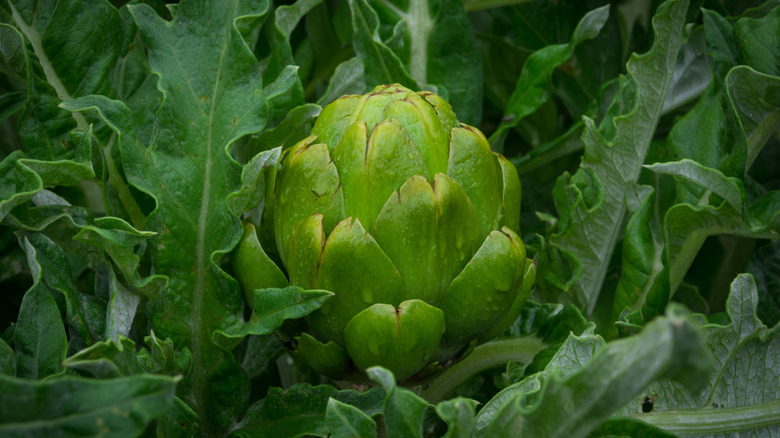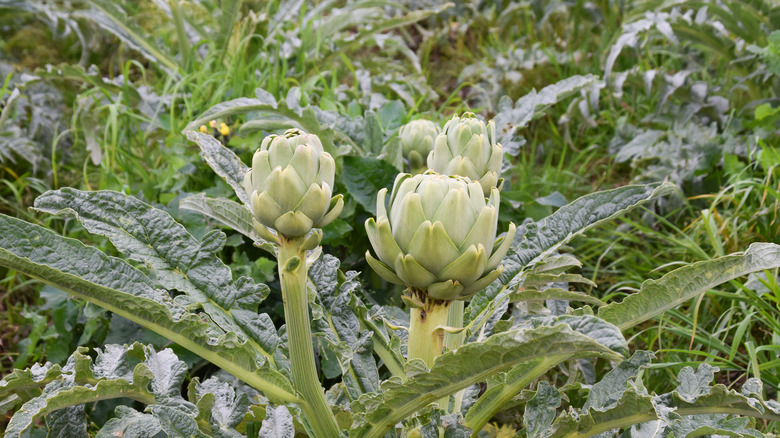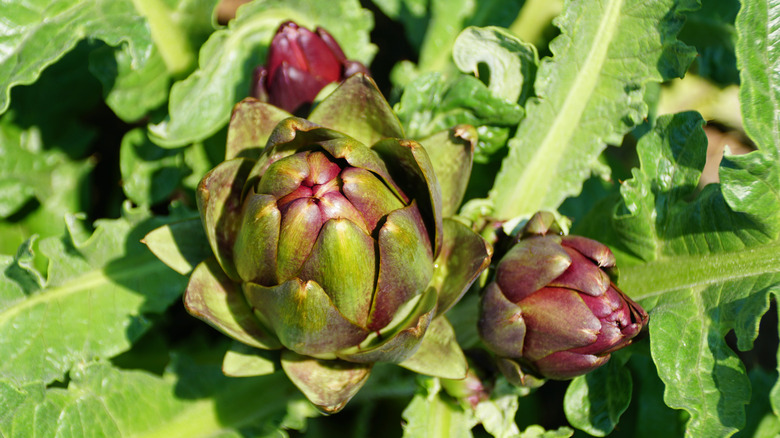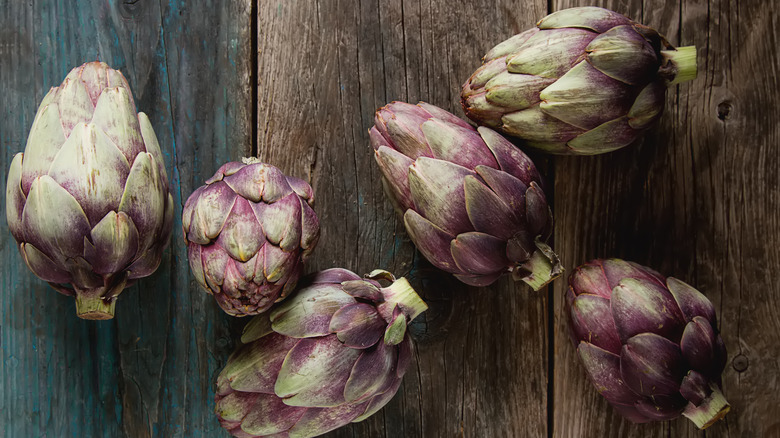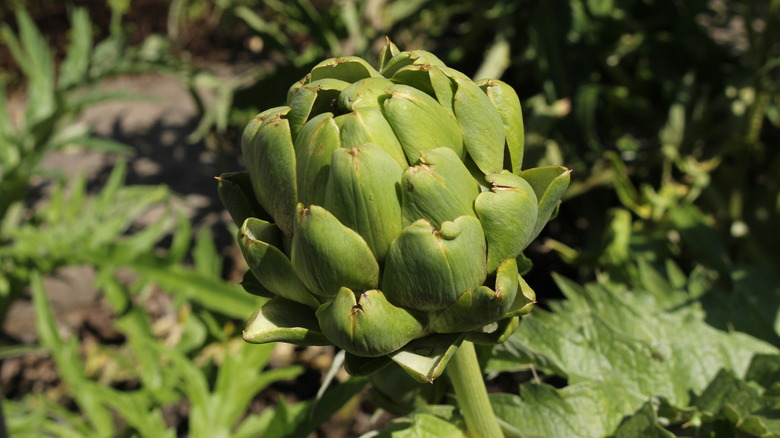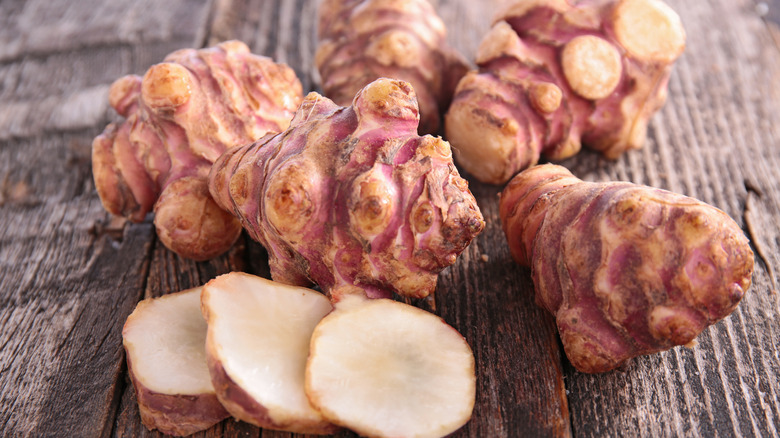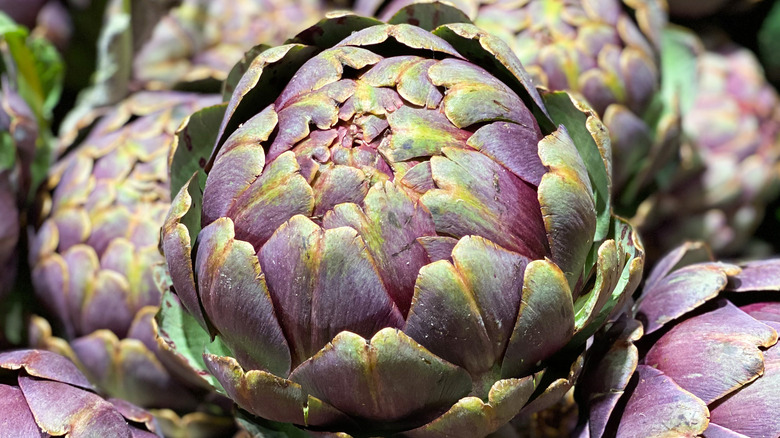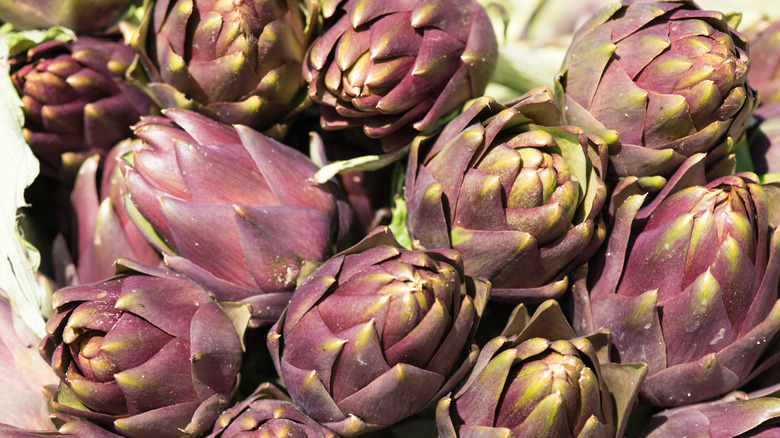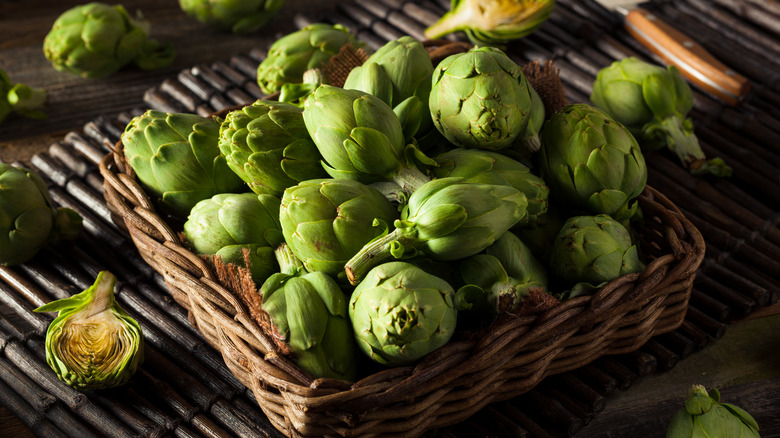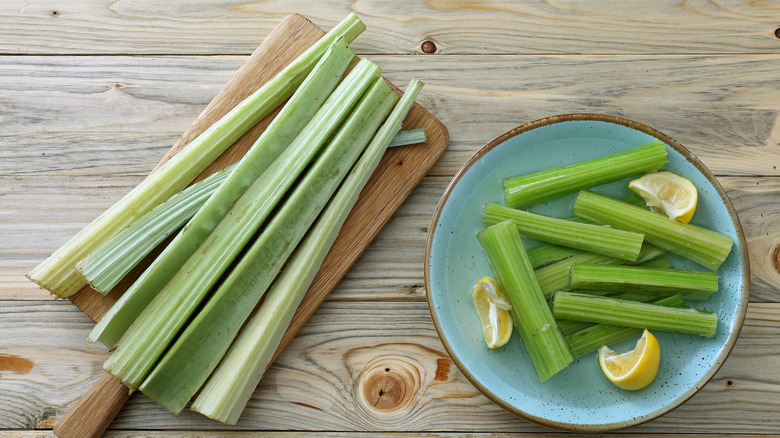14 Artichoke Varieties You Might Not Be Familiar With
There are some vegetables you buy regularly and some that probably aren't on your weekly shopping list. As an underrated food, artichokes can easily be dismissed as a challenging vegetable to work with. Most of us may not think to eat artichokes until we come across them on the menu of a fancy restaurant. Usually round or globe-like in appearance when they grow, artichokes are primarily appreciated for their hearts, which are, in fact, the early flower bud of the plant, and which are commonly found in salads, pasta, and on top of pizza.
Not just delicious, artichoke is also full of important nutrients for your body and is especially loaded with antioxidants that support cardiovascular health, according to Healthline. But the main reason that we adore artichokes is because of the wild variety of options available. Artichoke is a vegetable that grows in different shapes and sizes, and each type has a specific flavor and culinary use. So, if you've ever wanted to get more familiar with the different varieties of artichoke out there, we've got you covered.
1. Emerald
The beautiful emerald artichoke is as much a joy for the eyes as it is for the stomach. Growing in a vivid green shade that matches its name, emerald artichokes can be slightly oval-shaped and sport thick, fleshy leaves that curl around its heart. Emerald plants grow to around 4 to 5 feet tall, with the edible parts growing on the very tip. Although they're a year-round vegetable, they tend to thrive in warmer conditions and work well in sunnier climates.
Emerald artichokes sport a juicy heart that has great flavor and can be used in seemingly unlimited ways. Its leaves are also partly edible. So, if you don't want these to go to waste, they can also be employed in the kitchen by roasting the whole plant with some seasonings.
Our favorite way to prepare emerald artichokes, though, is by combining them with salmon to make roasted salmon and artichoke hearts. Remove the heart from the emerald artichoke and place them in a bowl of water with some lemon juice if you're not using them immediately to stop them from oxidizing and changing color. When you're ready to cook, chop them up and place them in a pan with a salmon fillet, salt, pepper, and olive oil.
2. Big Heart Seed
Big Heart Seed artichokes live up to their name, not just because they're a variety with a lot of love put into creating them. This variety is one which, as you might expect, sports a particularly large heart inside its dense leaves. A veritable sub-section of artichokes in themselves, Big Heart Seed was developed by farmer Rusty Jordan, who since 1989 has been perfecting the cultivar.
The result is an artichoke type that is at once tasty, hardy, and able to thrive in less-than-perfect conditions, batting off diseases and invaders. Jordan's nurturing of the plant type and branching out to different formulations means that Big Heart Seed artichokes don't simply have one particular look but can vary considerably.
These artichokes can grow in vibrant purple, green, or a mix of both colors. They can also be perfectly round or a little more egg-like in shape and can grow to larger sizes or remain smaller. The common denominator is the size and plumpness of the heart nestled inside, which serves as a delicious addition to any meal you care to name.
3. Colorado Red Star
Artichokes are often green, but that's not the only color they can be. They can also grow in hues of bright purple or be a mix of the two colors. Colorado Red Star is a good example of a two-tone artichoke, with a base color of purple on its leaves, turning green towards the spine of each one.
Colorado red star artichokes tend to be a little shorter than other artichoke varieties, reaching about 3 feet in total before being harvested. It's also a quick grower, usually coming into full maturity at approximately two and a half months. The advantage of the Colorado Red Star is that it is slightly smaller than others, making it an excellent choice for gardens with less space or where you're worried about plants peeking over your fence.
As you might expect with a smaller plant, the heart of the Colorado Red Star is a touch more compact than other artichoke hearts. This also impacts its flavor, which is sharper and slightly sweet. This makes the Colorado Red Star a great choice if you're looking for a more full-bodied taste or need your artichoke to shine in a dish.
4. Baby Anzio
Okay, now these artichokes are cute. The Baby Anzio variety is one of several baby artichokes which, predictably, grow smaller than its vegetable siblings. Baby Anzio's are especially teeny and can be as small as two centimeters in diameter. Despite this, they're rich in various nutrients, with vitamins B, C, and K contained in their leaves, as well as fiber.
Baby Anzio artichokes hail from the Mediterranean and are often found in France, Spain, and Italy but have gained a footing in the United States in the last few decades. They generally grow in green-purple and can be slightly thorny on their outside layers, so make sure that you pull these out before cooking. Although larger artichokes are usually used for their hearts, leading to a fair amount of wastage of the rest of the plant, Baby Anzio's are a plant that you can, and really should, prepare whole.
They're also super-versatile and can be cooked however you like, with our favorite approach being to braise them with some aromatics and a ton of butter. When cooked, they have a pleasing nuttiness, and this bold flavor allows them to take center stage in a meal, add extra flavor to salads, or accompany grilled meats well.
5. Fiesole
As with other baby artichokes, Fiesole artichokes are small in size. A relatively new artichoke strand, the Fiesole was developed in 2004 in California and has taken the artichoke world by storm. They sport bright purple leaves that curl upwards in a tulip formation, with the leaves often being fringed by green edges.
Their purple color gives them some exemplary health advantages and means that they may be even more nutritious than regular green artichokes. Purple artichokes, like other purple vegetables, have pigments called anthocyanins in them. These anthocyanins have an antioxidant effect and, when eaten, go to work on limiting free radical damage in our bodies, helping to prevent disease, according to BBC Good Food.
But Fiesole artichokes aren't just good for their health properties, as exciting as they are. They're also good for the flavor that they bring to the table. The Fiesole variety has a full flavor with a pleasant richness that makes them the star of the show. These artichokes are fully edible and can be cooked whole, ideally with ample amounts of fat, salt, pepper, and garlic, to boost their natural flavor. Fiesole artichokes are also excellent when pickled.
6. Lyon
If you're looking for a classic-looking artichoke, the Lyon variety is where it's at. Lyon artichokes can grow to up to two pounds in weight and are notable for their uniform leaf formation, with thick green leaves pointing upwards. This artichoke is usually round or near-round and grows on a robust stalk, usually ready to harvest in the early summer months. True to their name, Lyon artichokes originate from France and are an older variety that more modern cultivars have arguably taken over.
As a result of this, they tend to be more readily available in specialist stores and from farms, although, in European countries, they're more common. But the relatively difficult task of finding them is more than rewarded by their taste. Lyon artichokes have a tender heart and a wholesome flavor with slightly earthy undertones and can become smoky and rich when char-grilled or fried.
The classic way to prepare Lyon artichokes is by steaming them whole, allowing them to cook and soften gently. Cooking them is essential, as Lyon artichokes can't be eaten when they're raw. Once they've tenderized in your steamer, you can then pluck off parts of the artichoke and dip them in a fresh aioli for a taste sensation.
7. Imperial Star
The Imperial Star artichoke has a name that's slightly reminiscent of a certain "Star Wars" space station, but there's nothing deadly about this plant. On the contrary, imperial star artichokes are vegetables that brim with vitality and health. As an annual plant in colder climates, Imperial Star artichokes may need to be planted each year, but the reward you get is a hardy plant that produces a smooth head.
The plant can reach 5 feet tall, and the resultant artichoke tip is pretty big, with a gentle green shade across its body. While some artichokes can have a relatively sharp taste, Imperial Star artichokes tend to be tender, with a milder, more subtle, sweet flavor. With their meaty hearts, the Imperial Star variety is the perfect choice for a next-level fresh and healthy artichoke dip.
All you have to do is steam them until they're soft, remove the leaves, and slice the hearts. Then, combine them with some cooked bok choy, or you can use spinach if you prefer, Greek yogurt, a beaten egg, and some seasonings. Put the mixture in a fairly deep tray, dust some parmesan over it, and broil it until it's crispy on the top and creamy and delicious underneath. Grab a cracker and go to town.
8. Jerusalem
Artichokes have a pretty classic look, right? A green or purple spiny, round exterior, diamond-shaped leaves that curve upwards, and a fleshy center. But just wait until you learn about Jerusalem artichokes. Most importantly, Jerusalem artichokes aren't really artichokes, hailing instead from the sunflower plant — but as it has artichoke in its name and a delectable taste, we thought it merited a mention all the same.
A winter vegetable, Jerusalem artichokes look more like potatoes or unpeeled ginger than classic artichokes, with a brown-purple exterior and a variable shape. When sliced open, though, they reveal a white interior and are a great addition to any recipe that calls for root vegetables.
You can use Jerusalem artichokes much like you would potatoes, although they have a slightly sweeter edge to their flavor. If you want them to have a more subtle presence in your food, they can be boiled until soft and then blended into a soup with other veggies. If you want them to shine, though, try frying them up and adorning them with your favorite seasonings.
9. Romanesco
You'd be forgiven for thinking that the Romanesco artichoke was some kind of armadillo-like creature at first glance, such is the shine and robustness of its leaves. But this variety is a tasty and, when cooked, tender treat. Romanesco artichokes have purple-silver exteriors, which become greener towards its stem, and are almost totally spherical. Most commonly found in France and Mediterranean settings, they grow best in slightly warmer temperatures and can be susceptible to frost.
Romanesco is particularly prized for its flavor and, as such, should be prepared carefully. It's important to give it the necessary time to soften before you cook it, as without doing so, Romanesco artichokes can be too tough. It's best to soak them in a bath of salty water for a few hours, and then this vegetable should be cooked simply, either steaming, boiling, or roasting it at a low temperature.
Your patience will be rewarded, as what you'll end up with is a super-soft plant that's best when enjoyed for its full flavor and not adorned with too many seasonings or additional elements. A simple accompaniment of salted butter will do wonders for this vegetable.
10. Omaha
If you like your vegetables to be a multicolored affair, look no further than the Omaha artichoke. These dynamic plants are a mix of green, purple, and even burgundy and other deep reds, with the color tending to lighter shades towards the center of the vegetable. The origins of Omaha artichokes are unclear, but it appears to have developed from heirloom varieties into a highly-regarded crop. Omaha artichokes grow pretty big, sometimes reaching 15 centimeters in diameter, in a round shape.
This artichoke variety is especially well-regarded for its taste and the lack of acrid, bitter notes that can sometimes plague other kinds. They instead offer a heart and lower leaf portion that's gentle and buttery-tasting, with slightly grassy flavors in them too.
Given that bigger artichokes like Omaha are generally much denser and tougher than baby artichokes, which haven't had as much time to develop, they need to be cooked thoroughly, and you'll need to avoid certain inedible parts of the plant. Thanks to their richer flavor, Omaha artichokes are great for making into dips or being used as a stuffing, or paired with stronger-tasting cheeses.
11. Violetta
There's a pretty clear clue for the coloring of this artichoke in its name. And true to form, Violetta artichokes are immediately recognizable by the violet shade of their scales, with blue and pink colors scattered in there too. Doesn't that sound pretty, folks? Violetta artichokes can look almost flower-like in appearance, with longer, triangle-shaped leaves that spread wide and a cone-like shape. This variety is a classic in Italy and nearby areas and has been cultivated for generations.
The Violetta's appearance means that as well as being used in kitchens and recipes worldwide, it's also prized for its ability to bring beauty to your garden. But, while you might want to keep your hands off this artichoke for the risk of ruining the aesthetic of your outdoor spaces, sooner or later, you'll want to try it in your food. Violetta artichokes have a great taste, with a beefy heart and an earthy flavor. There's a reason why these have been around for so long — people love cooking with them, and we're pretty sure you will too.
12. Cocktail artichokes
You should pick up these little artichokes the next time you see them. Cocktail artichokes are especially popular on the West Coast and in California, and as a smaller variety, they can slot into a host of recipes easily. This variety tends to have a jade-green coloring with flecks of purple here and there, with an ovular, slightly egg-like shape. Only growing to a few inches in length, they're pretty tender when harvested, so they can be eaten both cooked and raw, which isn't the case with their larger cousins.
For their size, Cocktail artichokes contain a good whack of fiber and a wealth of important minerals. They can sometimes be a little sweeter, which is often the case with miniaturized vegetables due to their earlier harvest. You can use Cocktail artichokes in pretty much any artichoke recipe. For a super-fancy touch, though, try marinating them. Place them in a large jar with some oil, lemon, garlic, salt, pepper, and any herbs of your choice. Leave the flavors to meld and permeate the artichokes for a few hours before fishing them out and serving them as part of an antipasto platter.
13. Tavor
Farmers across the world are constantly striving to make their plants better with each season that passes, and this selective cultivation can result in some awesome vegetable varieties. Tavor artichokes are a testament to this. This artichoke type has been developed to be a super-strong grower and can continue to thrive even in chilly conditions. For this reason, Tavor artichokes are fantastic choices for people growing vegetables in cooler parts of the world. As a perennial, they'll also re-grow for several years after planting them.
When they're fully mature, Tavor artichokes are medium-sized and have wide heads with stout leaves. As good as they are in the kitchen, their unique look makes them an attractive option for people who are growing artichokes for their appearance and the variety they bring to a garden. Leaving the artichoke to grow for longer will allow it to flourish, producing a bright purple flower that's a visual knock-out. If you're keen on using it in the kitchen, though, Tavor artichokes are good pickling options.
14. Cardoons
Anyone who's ever seen a cardoon will probably be pretty confused as to why they're on this list. After all, they look nothing like the classic artichokes you know and love. But the two share some very similar qualities, and it appears to have some genetic history. Commonly known as wild artichokes, cardoons are green stalks that can grow to nearly 5 feet tall and look almost like celery, with strong leaves sprouting from the body.
A winter vegetable, they're most available during the early months of the year but are pretty rare to find outside of specialist settings like farm shops, partly because they have traditionally been tricky to grow. However, while they're not the most popular vegetable out there, they have a flavor that needs to be tried. Cardoons taste very similar to artichokes — as they are in the same family — and can be quite sweet, especially when cooked low and slow.
Blanching cardoons in salted water for a good length of time can help to remove any bitterness that may have developed in the plant. Once that's done, you can use cardoons in almost any setting that asks for artichoke hearts. Marinating them or blending them into a dip is a great way to bring out their natural nuttiness. Remember, though, they won't taste exactly like artichokes, but they're a great alternative and a must for anyone looking for more variety in their vegetable drawer.
